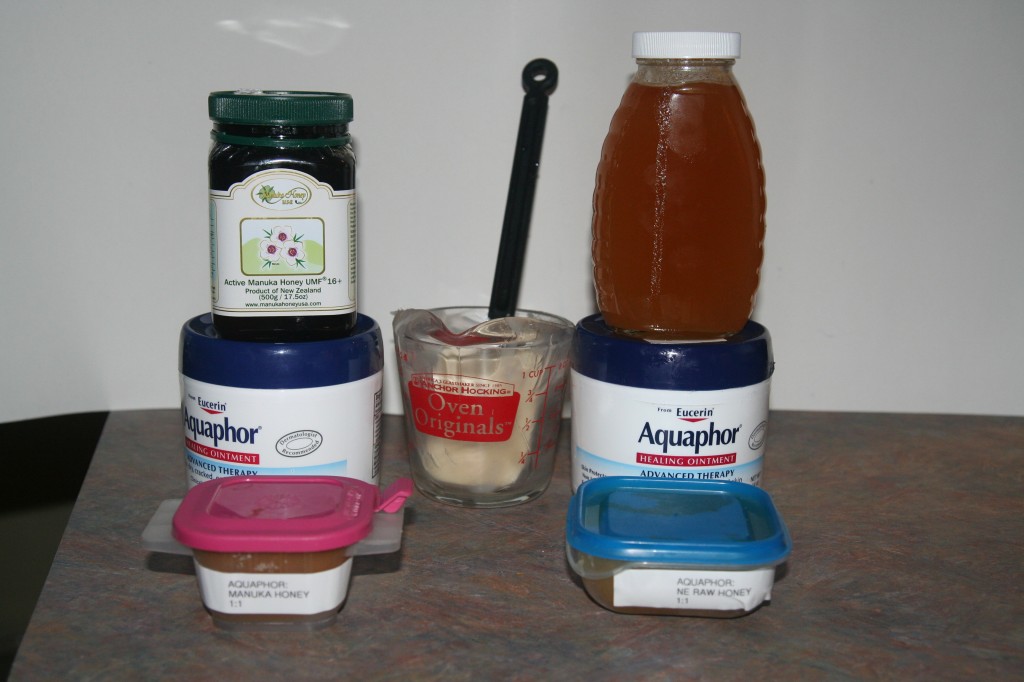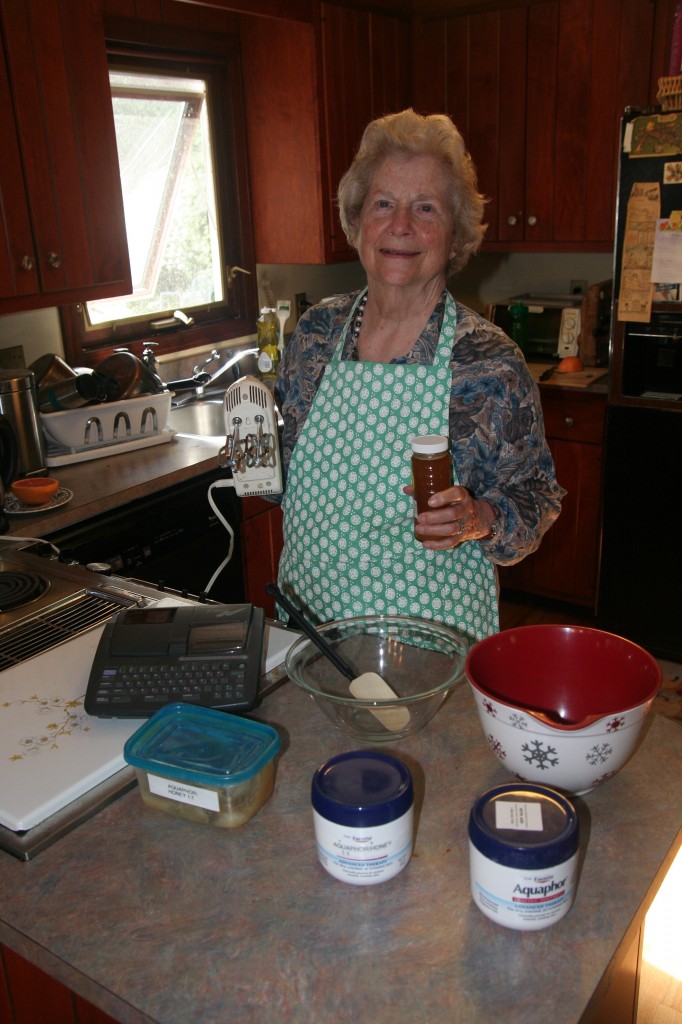Make Your Own Honey Ointment!
Materials required:
- 1 oz local raw honey or imported manuka honey or Medihoney ™ (Honey with crystals is extra potent and prized for medical use)
- 1 oz Aquaphor (may use Un-Petroleum TM (Alba Botanica—Ingredients: Castor seed oil, coconut oil beeswax Available on web if there is objection to petroleum products or if allergy to lanolin, but less clinical experience with wound healing)
- 1 2 oz plastic cosmetic jar with threaded sealable cap (available in pharmacies)
- 1 label or marker pen
Mixing:
Run hot water bath over ingredients for 30 minutes to bring up to about 105
deg F. but do not boil water or ingredients. Wash hands before mixing. Add 1 oz of
honey and aquaphor to jar. Mix thoroughly with small butterknife for 1 minute. Increase
recipe proportionally and mix with hand mixer. Mixing vessels should be clean from
dishwasher but need not be sterile. Label with contents (eg. Raw Honey: Aquaphor 1:1,
your name and date) Shelf life is unknown, perhaps many years. Refrigeration can be
used to prolong shelf life but ointment may be stiff and hard to use unless rewarmed
before use.
Dressing wounds:
First, irrigate wound with sterile saline. Pat dry with sterile guaze.
Wounds with profuse bleeding which are new (less than hours old) may do better with
sutures (stictches) in a clinic or ER. Hydrogen peroxide can be useful for initial cleaning
of grossly contaminated wounds but is toxic and delays healing when used at dressing
changes. Deep wounds sometimes do best with pure honey covered with non absorbent
gauze dressing. Superficial wounds are easier to manage with above ointment to control
honey’s tendency to run at body temperature. Cover wounds with nonabsorbent gauze.
Plastic adhesive dressing covers are now available popular and practical. Clear plastic
dressings may allow patient to wash, even shower. Honey based dressing can and should
be left in place for 3-4 days to avoid disturbance of wound matrix. Change dressing
sooner only if pain, fever, drainage, or soiling or wetting of dressing. Infection of such
wounds is very rare. Honey reduces risk of infection, cost of materials, labor, time and
pain associated with dressing changes. Odor is eliminated.
Important
Call your Doctor if increased pain, drainage fever, chills or growing redness or swelling
about the wound. Streaks heading to center of body may be warning of spreading
infection requiring a medical visit.


Richard on December 22, 2012 at 4:46 am said:
What at home process, if any – will crystalize local honey?
Allen on December 27, 2012 at 3:30 am said:
My experience with patients is that they dislike the sensation of the application of “granulated” honey ointment which feels like liquid sandpaper going on. I do educate patients that this honey ointment, with its low water content, is the best for 3 to 5 day dressings. The concentration of honey as a gel of sugars fructose and glucose is mainly accomplished by the fanning motion of the wings of thousands of worker bees. Honey from humid conditions will have slightly higher water content than that from arid areas. Honey which is harvested and spun with unsealed cells may have partly processed me tars with higher than desirable water content. Judging of honey at State Fair and other contests involves, among other tests, measuring water content with an instrument called a refractometer. Master beekeepers counsel beginners to spin capped honey frames on dry days or in air conditioned or dehumidified honey houses. I refer you to more authoritative sources such as the Wikipedia entry on “honey” for an in depth treatment of the subject. If you store honey in a shallow pan in the above low humidity area , covered with, say, cheesecloth, to limit the settling of dust, it will no doubt dehydrate in time further enough to initiate formation of crystals. Medicinal honey ointment should be kept tightly capped at room temperature to avoid adsorption of airborne humidity. “Creamed” honey is produced by stirring honey fast at higher than body temperatures. It is delicious and has a great texture for speading on food; however, the heating and stirring tend to denature the proteins which are part of the healing quality of raw honey. Creamed honey is therefore unsuitable for medical use. Sorry to go on and on and I hope the answer you seek is somewhere in all that!
Anne on March 28, 2014 at 4:45 pm said:
I showed up at my Aunt’s house with frostbite on eight toes from this hard winter. She had me put some of the ointment on my toes. This is day one and the difference is amazing! I will let you know if it works. Thank you!
Allen on April 3, 2014 at 5:03 am said:
What a terrific aunt you have to know about honey ointment and honeyointment.org! Deep frostbite is understood by experts to involve small blood vessel occlusion and cell death. At my local university hospital surgeons are resorting to use of intravenous thrombolytic medications like tissue plasminogen activator (TPA) to reopen the blood vessels with some success. Therefore, no such topical treatment should help. In a case of superficial skin damage, perhaps it will help. Bad frostbite will, in time, demarcate into gangrene. The ointment will protect from infection from the outside until a qualified surgeon makes a decision about intervention or no. Send us pictures and I will post them.
Allen on January 13, 2018 at 11:15 pm said:
Hi Ann. It has been a few years since your frostbite. Sorry I misplaced your comment and then found it today. How did your toes turn out? Honey Ointment is the best thing out there for damaged skin and even deep tissue injuries. Only third degree burns are faster and better treated by a surgeon with skin grafting.